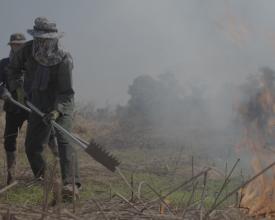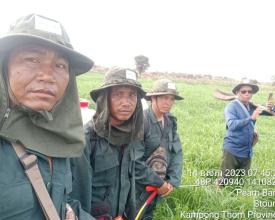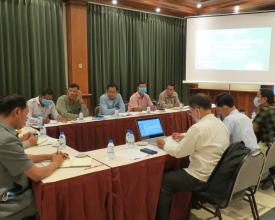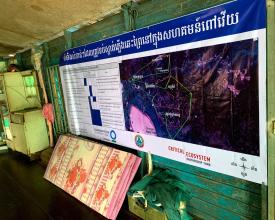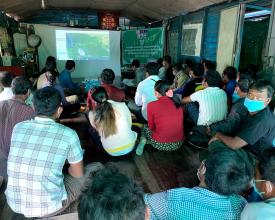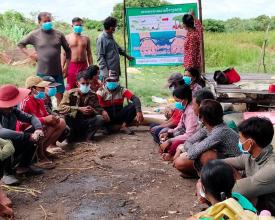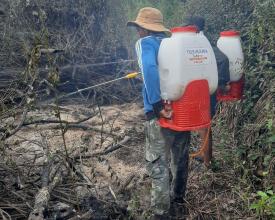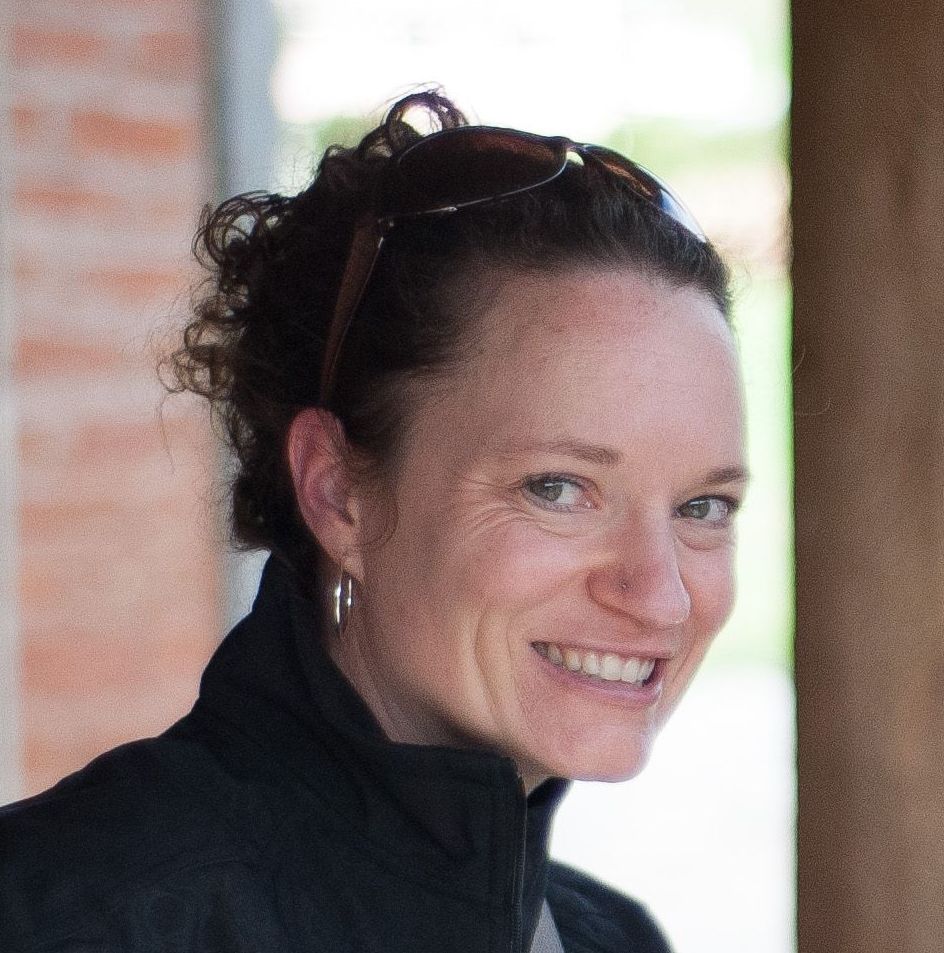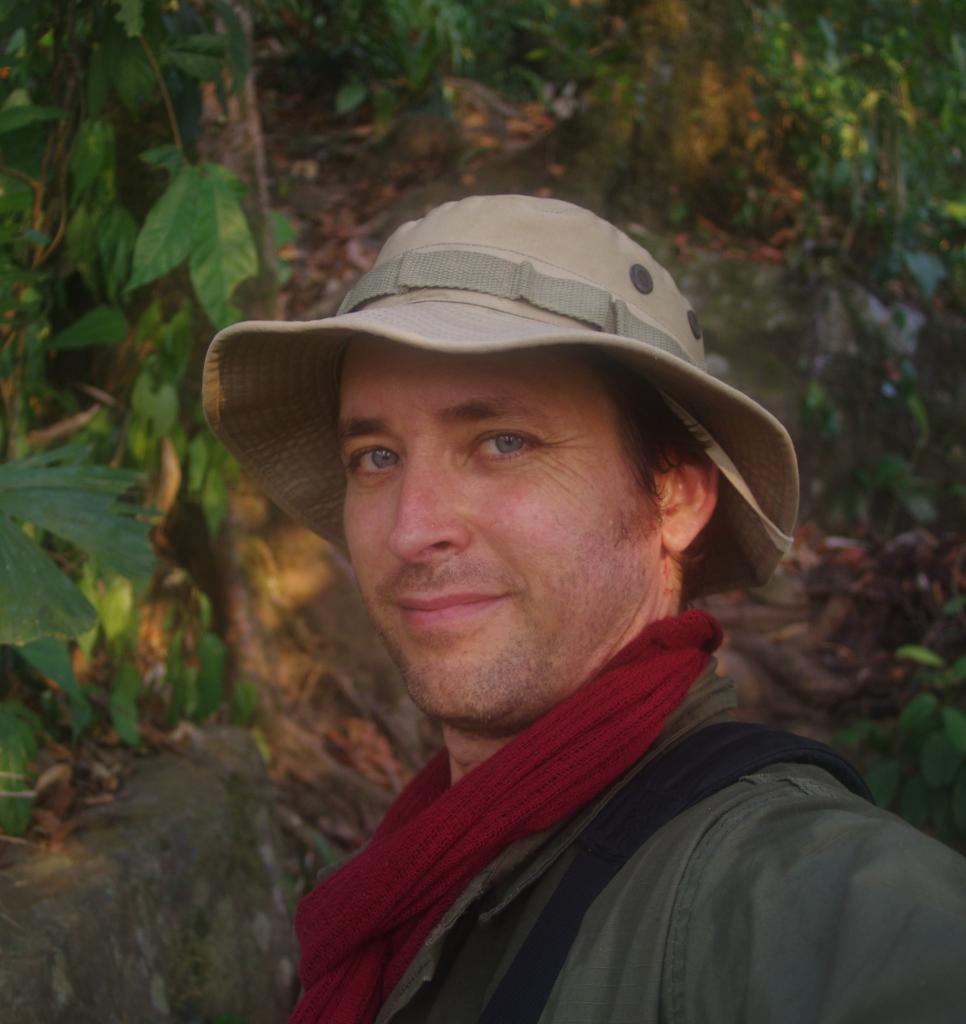Gestion communautaire des incendies de forêt sur le lac Tonle Sap

Les feux de forêt de la saison sèche détruisent la forêt inondée du lac Tonle Sap et endommagent sa pêche. En raison du manque de ressources, les communautés locales ne pouvaient que regarder leurs forêts brûler. En 2019, Conservation International a commencé à travailler avec quelques communautés locales de pêcheurs pour lutter contre les incendies de forêt en leur fournissant du matériel de base pour la lutte contre les incendies. Depuis lors, nous avons développé et mis en œuvre la gestion communautaire des incendies (CBFiM) dans 17 communautés. CBFiM est une approche communautaire holistique de la gestion des incendies qui vise à prévenir et à contrôler les incendies et à améliorer les moyens de subsistance, la santé, la sécurité et la conservation des zones sauvages. Le CBFiM est basé sur l'approche des 5R :
- Examen - identifier les problèmes liés aux incendies et les possibilités de changement
- Réduction des risques - prévenir les incendies.
- Préparation - se préparer aux incendies de forêt.
- Réponse - contrôler et éteindre les incendies de forêt.
- Rétablissement - restaurer les zones endommagées.
Ces collectivités disposent désormais des ressources et de la confiance nécessaires pour prévenir et éteindre les incendies de forêt dans le cadre de la gestion durable des forêts.
Contexte
Défis à relever
Les forêts inondées et les zones arbustives du lac Tonle Sap constituent un habitat vital pour les poissons pendant la saison humide. Leur destruction par les incendies réduit donc l'abondance et la diversité des poissons et, par voie de conséquence, accroît l'insécurité alimentaire des communautés de pêcheurs du lac. En outre, les incendies de forêt sont exacerbés par les saisons sèches plus longues et plus chaudes causées par le changement climatique.
Bien que le CBFiM ait permis à nos communautés partenaires de gérer les incendies de forêt, les défis persistants comprennent le besoin de :
- d'une formation avancée à la lutte contre les incendies
- d'une plus grande coopération entre les équipes communautaires de gestion des incendies et les autorités locales ; et
- des campagnes de sensibilisation améliorées et plus étendues.
Les communautés sont également confrontées aux défis suivants
- l'insuffisance des ressources financières et humaines pour mettre pleinement en œuvre le CBFi ;
- la difficulté d'impliquer les jeunes membres de la communauté dans la gestion des incendies ;
- des capacités de gestion limitées au sein des équipes de gestion des incendies de la communauté ; et
- la difficulté à éteindre les grands incendies.
Emplacement
Traiter
Résumé du processus
Les six composantes sont complémentaires. Le bloc 1 - Engagement de la communauté et du gouvernement - établit l'environnement propice à l'élaboration et à l'intégration de la gestion forestière communautaire dans la planification de la gestion des ressources naturelles de la communauté. Les blocs 2 à 6 font partie d'un cycle de gestion adaptative, tous deux se répétant entre les saisons d'incendie. Chaque saison d'incendie fait l'objet d'un examen (bloc 2 - Examen), ce qui permet d'affiner les stratégies de réduction des risques (bloc 3 - Réduction des risques), la préparation aux incendies (bloc 4 - Préparation), la suppression des incendies (bloc 5 - Intervention) et, à la fin de la saison d'incendie, les activités de restauration (bloc 6 - Restauration). Au cours d'une saison d'incendie, le cycle est réduit et comprend les blocs 3, 4 et 5.
Blocs de construction
Engagement des communautés et des gouvernements
Tout d'abord, nous identifions une communauté appropriée, c'est-à-dire une communauté menacée par le feu, qui a la volonté de s'attaquer au problème et qui, idéalement, dispose d'un groupe communautaire établi. Sur le lac Tonlé Sap, nous avons travaillé avec des organisations communautaires de pêche (CFi), des organisations communautaires de zones protégées (CPA) et des villages pour mettre en œuvre la gestion communautaire des feux de forêt. L'engagement d'une organisation communautaire formelle dotée d'une structure reconnue présente plusieurs avantages, notamment un leadership communautaire reconnu, une capacité de gestion, des ressources financières telles que des comptes bancaires et la reconnaissance par les autorités locales. Tout d'abord, nous demandons l'avis des autorités locales pour savoir quelles sont les communautés qui ont les capacités nécessaires pour participer au projet CBFiM. Nous rencontrons ensuite les dirigeants de la communauté pour obtenir leur soutien, avant d'entrer en contact avec les groupes d'épargne féminins qui peuvent apporter un soutien financier. À partir de là, nous mettons en place l'équipe communautaire de gestion des incendies de forêt, qui doit être intégrée aux autorités du village et de la commune. L'équipe communautaire de gestion des feux de forêt constitue la base de la gestion communautaire des feux de forêt.
Facteurs favorables
La mise en place d'un CBFiM nécessite
- une communauté engagée disposant d'une capacité de gestion suffisante et du soutien des autorités locales.
- La présence d'un groupe communautaire établi, tel qu'une pêcherie communautaire ou une zone protégée communautaire, n'est pas indispensable, mais elle fournit une structure sur laquelle la gestion fondée sur les droits de l'homme peut être adaptée et développée.
- Un soutien fort des autorités locales au niveau du village, de la commune et du district.
Leçon apprise
En engageant les communautés et le gouvernement, nous avons appris que :
- Comme les dirigeants communautaires tels que les CFi et les membres du comité CPA ont tendance à être des hommes âgés, nous encourageons la diversification de l'équipe communautaire de gestion des feux de forêt en engageant des femmes et des personnes plus jeunes.
- Les femmes ont un rôle important à jouer car elles gèrent traditionnellement les finances du ménage et peuvent rappeler au groupe de gestion des incendies qu'il faut se préparer à la saison des incendies.
- Les jeunes membres, bien que souvent difficiles à engager, apportent une plus grande énergie au travail physique difficile de la lutte contre les incendies.
- Obtenir le soutien des autorités locales dès le début permet de les intégrer dans le plan de gestion de la communauté, qui peut être élaboré par le biais d'un engagement au niveau du district et de la province.
- Le soutien continu du gouvernement est assuré par des réunions fréquentes de l'équipe de coordination des pêches, qui rassemble les communautés et le gouvernement pour discuter des problèmes de pêche, y compris des incendies de forêt.
Examen - identifier les problèmes d'incendie et les options de changement
Une fois que nous avons mis en place une équipe communautaire de gestion des incendies de forêt, nous examinons les problèmes locaux liés aux incendies de forêt et identifions les possibilités de changement à l'aide d'une série de méthodes participatives. Notre objectif est de comprendre comment et pourquoi les incendies se déclarent au sein de chaque communauté et quels sont les impacts positifs et négatifs des incendies déclenchés pour différentes raisons et dans différentes zones. Nous recommandons d'interroger diverses personnes, notamment les membres de l'équipe communautaire de gestion des feux de forêt, d'autres chefs de village et anciens, des femmes, des jeunes et des autorités locales.
Lorsque nous comprenons les causes et l'impact des incendies de forêt, nous procédons à une cartographie de la communauté afin de déterminer dans l'espace
- les endroits où les incendies sont les plus susceptibles d'être allumés et pourquoi ;
- les coupe-feu potentiels ou les lignes de contrôle dans le paysage ;
- l'emplacement des sources d'eau
- l'emplacement des routes d'accès et des pistes ;
- les zones à protéger en priorité (par exemple, les forêts de grande valeur et les zones de restauration) ; et
- la capacité des membres de la communauté locale à contrôler les incendies par des mesures de pré-suppression et de suppression.
Ces cartes des incendies ont aidé chaque communauté à mettre en œuvre des mesures de prévention, de détection et de réponse efficace aux incendies de forêt.
Facteurs favorables
Pour que l'examen des questions relatives aux incendies de forêt soit couronné de succès, il faut
- L'achèvement du bloc 1 - Engagement de la communauté et du gouvernement avant d'entreprendre le processus d'examen.
- Obtenir un large éventail de points de vue sur les incendies de forêt au sein de chaque communauté, car les communautés auront des moteurs, des réponses et des attitudes différents à l'égard des incendies de forêt.
- Il est essentiel de comprendre pourquoi les incendies de forêt se produisent, en particulier s'ils sont allumés pour profiter à certaines personnes, afin de gérer leurs effets néfastes.
Leçon apprise
En examinant les causes et les conséquences des incendies de forêt sur le lac Tonlé Sap, nous avons appris que :
- Les incendies de forêt sont provoqués par l'homme, et la plupart d'entre eux sont allumés délibérément.
- Le temps chaud et sec est un facteur important d'incendie de forêt. Le vent est le principal facteur de propagation du feu.
- Dans les communautés dépourvues d'équipement de lutte contre les incendies, la pluie est le principal facteur d'extinction des incendies.
- Nous recommandons d'imprimer et d'afficher bien en vue le plan annuel de gestion des feux de forêt de chaque collectivité, afin qu'il serve de rappel constant de la gestion des feux de forêt et des activités prévues.
Réduction des risques - prévenir les incendies de forêt
Avec la réduction des risques, nous travaillons avec les communautés pour prévenir les incendies de forêt, en concentrant les ressources sur leurs causes sous-jacentes. La prévention est une mesure de contrôle efficace, car presque tous les incendies sur le Tonle Sap sont causés par des activités humaines. Nos communautés partenaires ont identifié quatre stratégies de réduction des risques d'incendie de forêt :
- Organiser plusieurs sessions d'éducation et de sensibilisation aux incendies de forêt avec les membres des communautés locales et les migrants saisonniers.
- Installer des panneaux d'information et d'avertissement sur les incendies dans les zones à haut risque d'incendie et à haute valeur de conservation.
- Organiser des patrouilles conjointes de lutte contre les incendies avec les autorités locales et les responsables de la FiA.
- Identifier les migrants saisonniers qui se rendent dans la zone gérée par la communauté pour pêcher et faire paître les buffles. Les informer qu'ils seront interrogés si des incendies se déclarent autour de leur zone de campement temporaire.
- Punir les personnes qui détruisent la forêt inondée en appliquant la loi sur la pêche, qui peut entraîner une peine d'emprisonnement de 3 à 5 ans.
Facteurs favorables
Pour être efficace, la réduction des risques doit tenir compte des facteurs suivants :
- Les équipes communautaires de gestion des incendies ont besoin du soutien des autorités locales pour réduire les risques d'incendie. Cela est nécessaire pour approcher et travailler avec les migrants saisonniers qui ne sont pas connus des villageois locaux.
- Le soutien des autorités locales est également nécessaire pour traiter les aspects juridiques de la réduction des risques d'incendie, tels que la poursuite des contrevenants.
Leçon apprise
Les principaux enseignements tirés de la réduction des risques sont les suivants :
- L'installation de panneaux de signalisation - en particulier ceux qui décrivent les sanctions associées à l'allumage de feux - dans les zones à haut risque d'incendie et les sites de grande valeur décourage les gens d'allumer des feux et encourage un comportement responsable. Nous recommandons d'obtenir l'approbation des autorités locales avant d'utiliser ces panneaux et de leur demander conseil quant à leur emplacement.
- Organiser chaque année plusieurs séances d'information du public sur les incendies de forêt. Les sessions organisées avant la saison des feux visent à modifier le comportement des gens et à réduire le risque d'incendie. Les sessions doivent se poursuivre tout au long de la saison des incendies afin de s'assurer que les gens restent conscients du risque d'incendie de forêt.
- Comme les incendies de forêt sont causés par l'homme, l'équipe de gestion des incendies de forêt doit se concentrer sur l'éducation des membres de la communauté et des migrants saisonniers dont les moyens de subsistance dépendent de la pêche, et donc de la forêt inondée. Les pêcheurs migrants et les éleveurs de bétail devraient être impliqués car ils sont tenus pour responsables de l'allumage des incendies dans le passé.
- Encouragez les femmes à participer aux séances de sensibilisation et d'éducation, car elles sont les mieux placées pour rappeler aux membres de leur famille et à leurs voisins les causes et les dangers des incendies de forêt.
- Les membres de l'équipe de gestion des incendies doivent communiquer leurs coordonnées aux pêcheurs migrants, afin qu'ils puissent les informer s'ils détectent des incendies.
Préparation - se préparer aux incendies de forêt
Malgré les meilleurs efforts de réduction des risques, des incendies se produiront toujours et les communautés partenaires doivent être prêtes à les éteindre. Pour être prêts à lutter contre les incendies, les groupes de la DGFiP ont besoin de ce qui suit
- un équipement de lutte contre les incendies bien entretenu et d'origine locale, y compris des vêtements de protection ;
- d'une formation à la gestion des incendies ; et
- des alertes incendie en temps réel par satellite.
Chaque équipe communautaire de gestion des incendies de forêt doit effectuer des patrouilles fréquentes dans les zones à haut risque d'incendie pendant la saison des incendies. Cela leur permet d'identifier les comportements à risque et d'y remédier avant qu'un incendie ne se déclare, de surveiller les charges de combustible et d'évaluer les voies d'accès et la disponibilité de l'eau en cas d'incendie.
Facteurs favorables
Pour être prêt à éteindre un feu de forêt, il faut
- Une équipe communautaire de gestion des incendies qui fonctionne.
- Un système qui détecte les feux de forêt et peut alerter l'équipe de gestion des feux de forêt de la communauté.
- Des ressources externes sont nécessaires pour gérer les alertes aux incendies de forêt, car en raison de contraintes techniques et de la capacité de la communauté, elles ne peuvent pas être fournies directement aux groupes communautaires pour qu'ils agissent.
Leçon apprise
Les leçons à tirer pour être prêt à éteindre un incendie de forêt sont les suivantes :
- Fournir aux communautés des vêtements de protection en matériaux naturels tels que le coton, car le polyester est inflammable et très dangereux lorsqu'il est exposé à des feux ouverts. La fourniture de cet équipement de sécurité est importante car les vêtements de tous les jours de la plupart des membres de la communauté ne sont pas sûrs lorsqu'ils sont portés pour éteindre des feux de forêt.
- Nos communautés partenaires ont indiqué que les alertes aux feux de forêt d'OroraTech transmises par le personnel du projet les avertissaient fréquemment des incendies avant qu'ils ne soient observés sur le terrain. Ce service est extrêmement précieux pour elles, car elles peuvent réagir rapidement, enquêter et arrêter les incendies avant qu'ils ne prennent de l'ampleur et ne deviennent incontrôlables.
Ressources
Intervention - maîtriser et éteindre le feu de forêt
La mise en œuvre des actions décrites ci-dessus en matière d'examen, de réduction des risques et de préparation permet aux communautés de réagir aux incendies de forêt. Dès réception d'une alerte, l'équipe communautaire de gestion des feux de forêt envoie un membre de l'équipe ou demande à un membre de la communauté proche de se rendre sur le site et d'évaluer la situation. Lorsqu'un incendie actif est confirmé, l'équipe communautaire de gestion des incendies de forêt détermine s'il doit être éteint et, dans l'affirmative, se rend sur place et éteint l'incendie avec l'équipement approprié. Si l'incendie ne menace pas une zone arbustive ou une forêt inondée, l'équipe surveille la situation.
Une extinction efficace des incendies nécessite une planification sur le terrain et des rôles et responsabilités clairement définis au sein de l'équipe de gestion des incendies de forêt. Il est important qu'un plan clair et sûr soit élaboré et accepté par l'équipe quant à la manière d'aborder et d'éteindre les incendies, et quant au rôle de chaque membre de l'équipe à cet égard.
Il est important d'enregistrer les détails de chaque alerte incendie, de chaque incendie confirmé et des mesures prises pour lutter contre chaque incendie afin de pouvoir tirer les leçons de nos expériences et de gérer les incendies de manière adaptative à l'avenir. Ces informations sont nécessaires à la fois pour l'examen et le rétablissement des 5R.
Facteurs favorables
L'efficacité de la lutte contre les incendies repose sur les éléments suivants
- Un avertissement précoce de l'existence d'un feu de forêt
- Une équipe de gestion des incendies formée et confiante, capable d'éteindre les incendies en toute sécurité avec un équipement local bien entretenu.
Leçon apprise
Les leçons importantes à tirer de la lutte contre les incendies de forêt sont les suivantes :
- Les équipements locaux peu coûteux qui peuvent être adaptés à la lutte contre les incendies sont préférables aux équipements spécialisés importés et coûteux. L'expérience de nos partenaires communautaires en matière d'équipements locaux a démontré leur familiarité avec ces équipements, leur efficacité dans la lutte contre les incendies et leur facilité de remplacement.
- Divers outils peuvent être utilisés pour lutter contre les incendies de forêt. Les membres de l'équipe communautaire de gestion des feux de forêt ont indiqué qu'ils utilisaient le plus souvent des outils manuels tels que des râteaux, des houes et des couteaux de brousse pour enlever les matériaux inflammables et créer une barrière de terre nue. Ils ont également utilisé des pulvérisateurs d'eau à dos pour éteindre les feux de forêt.
- Si les équipes communautaires de gestion des feux de forêt utilisent souvent de l'eau pour éteindre les incendies, les pompes à eau et les tuyaux, plus grands et plus lourds, ne peuvent souvent pas être utilisés en raison de la difficulté d'accès aux sites et du manque d'accès à l'eau (par exemple, lac, ruisseaux ou étangs).
- Une description claire du terrain a aidé les équipes communautaires de gestion des incendies à décider du matériel à déployer. Par exemple, l'accès au site et la présence d'une source d'eau à proximité sont nécessaires avant de déployer une pompe à eau et des tuyaux d'arrosage.
Rétablissement - restaurer les zones endommagées
Le rétablissement après un incendie de forêt implique de veiller au bien-être des communautés, de réparer les infrastructures et de restaurer les paysages endommagés par le feu. C'est sur le lac Tonle Sap que les incendies ont le plus d'impact sur l'environnement naturel. Heureusement, les impacts directs des incendies sur les personnes et les infrastructures sont rares. Le rétablissement passe donc par la restauration de la végétation endommagée par le feu. Il s'agit de déterminer les zones qui peuvent être restaurées et celles qui doivent être laissées en l'état. Certaines zones, comme les chemins traversant une végétation épaisse, sont brûlées à plusieurs reprises pour éliminer les jacinthes d'eau et les herbes séchées afin de maintenir l'accès, ou des parcelles sont brûlées pour dégager l'espace nécessaire aux filets de pêche. Chaque communauté doit décider si ces zones peuvent être restaurées ou s'il vaut mieux les laisser intactes. D'autres zones peuvent être laissées à la régénération naturelle ou être activement restaurées à l'aide de techniques telles que la régénération naturelle assistée, la transplantation de jeunes plants cultivés en pépinière ou l'ensemencement direct d'espèces indigènes ( généralement Barringtonia acutangula, Diospyros cambodiana et Combretum trifoliatum). Cela nécessite généralement des ressources extérieures et l'élaboration de plans de restauration avec les communautés locales.
Facteurs favorables
Le rétablissement d'une forêt inondée à la suite d'un incendie de forêt nécessite
- Des membres de la communauté ayant l'expérience d'une série de techniques de restauration. Sur le lac Tonlé Sap, il s'agit le plus souvent de la propagation de graines dans une pépinière, avec des semis plantés sur le site de restauration.
- Une source de financement externe est nécessaire pour soutenir les activités de restauration en raison de la capacité financière limitée des communautés locales sur le lac Tonlé Sap.
Leçon apprise
Il est essentiel de renforcer lentement la confiance de la communauté dans la restauration afin qu'elle puisse augmenter la superficie des terres restaurées sur plusieurs années et gérer ces terres restaurées.
Impacts
La mise en œuvre de la gestion communautaire des incendies (CBFiM) dans 17 communautés du lac Tonle Sap a permis à ces dernières de
- Élaborer et mettre à jour leurs plans annuels de gestion communautaire des incendies ;
- Poser des panneaux d'avertissement d'incendie ;
- Informer les villageois et les migrants saisonniers de leur responsabilité de ne pas provoquer d'incendies de forêt ; et
- signaler leurs activités aux autorités locales compétentes.
Nous avons fourni aux communautés des équipements de lutte contre les incendies disponibles localement et avons transmis à chaque communauté des alertes en temps réel sur les incendies de forêt par l'intermédiaire d'OroraTech(https://ororatech.com/wildfire-service/). Cela leur a permis de réagir rapidement aux incendies de forêt. Depuis 2019, elles ont répondu à vingt-deux incendies de forêt qui, autrement, auraient brûlé de manière incontrôlée, et les ont supprimés.
Nous avons accordé à onze groupes d'épargne féminins des fonds CBFiM de 500 à 1 000 dollars américains qui ont généré 3 230 dollars américains d'intérêts. Cet argent peut être utilisé par leurs partenaires CFi pour la gestion des incendies. Nous avons dispensé une formation spécialisée en gestion des incendies à 78 personnes issues de groupes communautaires et d'agences gouvernementales locales, ce qui a renforcé leur confiance dans la gestion des incendies de forêt.
Bénéficiaires
Les membres des communautés de pêcheurs bénéficient d'une meilleure gestion des incendies. La réduction de l'impact des incendies sur l'habitat des plaines inondables est bénéfique pour environ 300 espèces de poissons et de nombreux oiseaux, mammifères et reptiles menacés figurant sur la liste rouge de l'UICN.
Objectifs de développement durable
Histoire
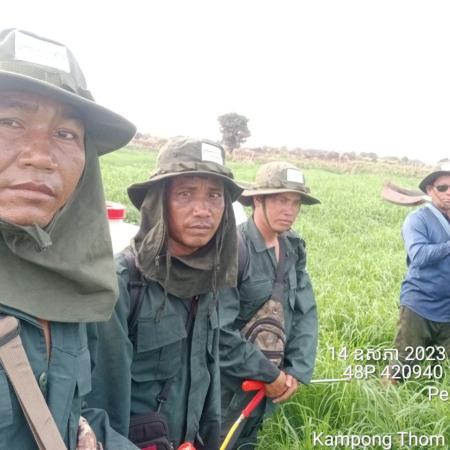
Nos partenaires communautaires sont enthousiastes à l'idée de contrôler les incendies de forêt, qui "sont pires que de couper la forêt inondée", selon M. Pen Sokhom, chef de la CFi de Kampong Prak. Les membres de la CFi de Doun Sdaeung ont quant à eux fait remarquer que "les cendres et les débris laissés par un incendie polluent l'eau et la rendent impropre à la vie des poissons". Tous les groupes communautaires ont trouvé extrêmement utile le système de détection d'OroraTech avec des alertes en temps réel sur les feux de forêt, fournissant des notifications sur les feux de forêt dont ils n'auraient pas eu connaissance autrement, avec des détails sur le lieu et l'heure des incendies. Les membres des pêcheries communautaires de Kampong Khnease et de Ou Ta Prok ont déclaré qu'avant le projet CBFiM, lorsqu'ils étaient confrontés à un incendie, ils ne pouvaient qu'essayer de vaincre les flammes à l'aide de branches coupées dans les arbres, ce qui ne réussissait jamais. Le CBFiM leur a fourni l'équipement et les connaissances nécessaires pour gérer les incendies de forêt et, surtout, leur a donné la confiance nécessaire pour s'organiser en équipe et éteindre les incendies en toute sécurité.

